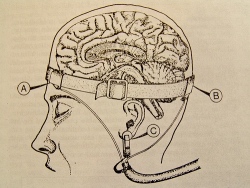
During the 1960s and 1970s, patients at a small Sydney private hospital called Chelmsford were subjected to a treatment known as deep-sleep therapy.
Patients were kept in a comatose state for days or weeks by massive doses of barbiturates. They lay naked on beds and were fed through tubes and were sometimes administered convulsive electrical shock treatment while in a coma.
The treatment’s major proponent, Dr Harry Bailey, claimed deep-sleep therapy cured depressive illnesses and compulsive behavior such as drug and alcohol addiction.
Other psychiatrists doubted the value of the treatment and were concerned about its risks. Dr Bailey and his small group of colleagues were the only psychiatrists to use deep-sleep therapy with any frequency.
Over a dozen of the patients given deep-sleep therapy at Chelmsford died while in a coma or shortly after their release from the hospital. Other patients at Chelmsford claimed they were inflicted with brain damage and paralysis as a result of the treatment.
That the tragedy of deep-sleep therapy was finally exposed to the public owes much to the persistence of two people who subsequently became clients of PIAC: Barry Hart, a former patient, and Jan Eastgate, president of the Citizens Committee on Human Rights (CCHR), backed by the Church of Scientology.
Mr Hart underwent treatment at Chelmsford in 1973 and was administered shock therapy against his will. In 1974, he spoke to the media of his ordeal. In 1976, he commenced civil proceedings against Dr Bailey and the hospital for assault and false imprisonment, which resulted in a damages award to him of $60,000 in 1980.
In 1980, the CCHR forwarded documents it had obtained from Chelmsford to the television program, 60 Minutes. The story 60 Minutes aired as a result of those documents was a powerful indictment of Dr Bailey and his colleagues and of government inactivity. The authorities were finally stirred to some action, but what followed was a lamentable series of bungles by different parts of the bureaucracy, which ultimately led to the striking out, 11 years later, of misconduct proceedings against the Chelmsford doctors because of this delay.
PIAC represented Mr Hart and Ms Eastgate in these disciplinary proceedings.
Mr Hart and Ms Eastgate had laid misconduct complaints against the Chelmsford doctors under the Medical Practitioners Act in 1980 and 1982.
About that time, several inquests were held into the deaths of patients and a criminal charge of manslaughter was pending against Dr Bailey. The Investigating Committee, which is responsible for dealing with complaints against doctors, decided to stay its hand until the criminal proceedings and inquests were completed.
In 1983, Ms Eastgate and Mr Hart came to PIAC for assistance in getting the Committee to start investigating the complaints.
PIAC wrote to the Committee arguing that it had an immediate duty to protect the public from unfit practitioners and that this task was entirely different from the criminal proceedings and should not await their outcome. The Committee was unmoved and in 1984 PIAC brought mandamus proceedings in the Supreme Court.
After further courtroom skirmishes, the Investigating Committee referred the complaints to the Disciplinary Tribunal, the body which de-registers doctors. After further delays, the de-registration hearing finally came on in June 1986. Dr Bailey had committed suicide in the intervening period.
PIAC solicitor, Mark Buscombe, and counsel, John Basten (now a Justice of the NSW Court of Appeal), represented Mr Hart and Ms Eastgate at the Disciplinary Tribunal hearings.
The Health Department, which had by then laid its own charges, was separately represented. At the opening of the inquiry, counsel for the other doctors involved in the treatment at Chelmsford argued that the disciplinary proceedings had taken so long to come on that they were an abuse of process and should be stopped.
The Disciplinary Tribunal rejected the argument that Mr Hart and Ms Eastgate had not diligently pursued their complaints and held that in any event the principle of abuse of process was overridden in disciplinary proceedings by the public interest in protecting further patients from unfit doctors.
The doctors appealed to the Court of Appeal and won. The judges gave predominant weight to the perceived hardship caused to the individual doctors by the long-running investigations and strongly criticised the authorities for the slowness and ineptitude of their inquiries. They also said that Mr Hart’s and Ms Eastgate’s reliance on the government to act over Chelmsford was no excuse for their own delay in prosecuting their own complaints.
An application for special leave to appeal to the High Court was lost. All disciplinary proceedings in relation to the Chelmsford tragedy were stymied.
The Chelmsford case was the first time a higher court in Australia considered the principle of ‘abuse of process’ on the ground of delay by the prosecution.
Not surprisingly, the judgment generated controversy amongst lawyers.
The Court of Appeal judgment throws a heavy burden on private citizens to bring complaints. A citizen cannot rely on the fact that a government agency will perform its duty, even though that agency must take individual action at the earliest possible point after the matter of complaint occurs.
If a government agency is dragging its feet, the citizen must force the agency to quicken its pace or prosecute the matter without the agency’s help. But it is difficult to think what more Ms Eastgate and Mr Hart could have done to expose Chelmsford.